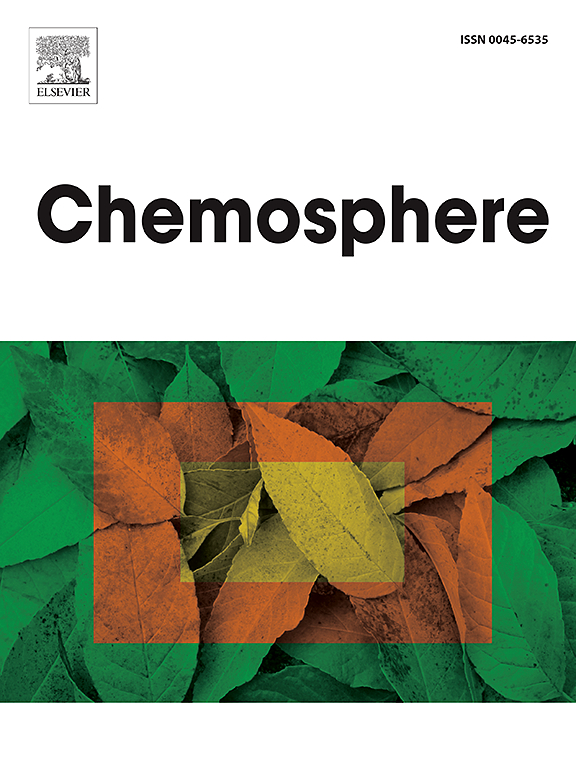铁基纳米结构颗粒通过诱导木霉的效应样基因和支原体相关基因来影响木霉的生物防治活性。
IF 8.1
2区 环境科学与生态学
Q1 ENVIRONMENTAL SCIENCES
引用次数: 0
摘要
生物防治微生物的使用是农业中用于对抗植物病原体造成损害的主要技术之一。在这些真菌中,木霉作为一种天然存在于农业土壤中的真菌而脱颖而出,它可以与各种化合物接触,比如纳米结构颗粒(NPs),这种化合物开始被用作杀虫剂和肥料。它们也可以通过各种人为活动进入土壤,例如水处理,因为处理后的水可以用于作物灌溉。因此,像木霉这样的微生物与这些NPs接触,这是否会影响它们的生长和生物防治能力尚不清楚。为了确定三种吸附材料(磁铁矿(Fe3O4),掺铝磁铁矿(Al-Fe3O4)和氧化银铁(Ag2-xFe x4 -x) NPs)是否有毒或对生物防治活性有影响,本工作的目标是将它们暴露于两种木霉。发现在100 ppm时,木霉在Fe3O4和Al-Fe3O4上生长成功,但在Ag2-xFe xO4-x NPs存在下不能生长。然而,有趣的是,这些纳米材料的存在有助于木霉更好地生物防治两种镰刀菌。此外,Al-Fe3O4和Ag2-xFe xO4-x NPs影响了支原体相关基因的表达。这些结果表明,这些材料的使用及其向环境的释放将与木霉产生协同效应,以抵消农业感兴趣的植物病原体。此外,还介绍了Ag2-xFe x4 -x NPs的合成、微观结构表征和氟吸附平衡。本文章由计算机程序翻译,如有差异,请以英文原文为准。

Fe-based nanostructured particles affect the biocontrol activity of Trichoderma species by inducing their effector-like and mycoparasitism-associated genes
The use of biocontrol microorganisms is one of the primary techniques used in agriculture to combat the damage caused by phytopathogens. Of these, Trichoderma sp. stand out as fungi species that are naturally present in agricultural soil and can come into contact with various compounds, such as nanostructured particles (NPs), which are starting to be used as pesticides and fertilizers. They can also enter the soil through various anthropogenic activities, such as water treatment, due to the treated water can then be used for crop irrigation. As a result, microorganisms like Trichoderma come into contact with these NPs, and it is unclear whether this will affect their growth and biocontrol ability. In order to determine whether the three adsorbent materials (magnetite (Fe3O4), Al-doped magnetite (Al–Fe3O4) and silver iron oxide (Ag2-xFe xO4-x) NPs) are toxic or have an impact on the biocontrol activity, the goal of this work was to expose them to two species of Trichoderma. Finding that, at 100 ppm, Trichoderma grows successfully on Fe3O4 and Al–Fe3O4 but not in the presence of Ag2-xFe xO4-x NPs. However, interestingly, the presence of these nanomaterials helps Trichoderma to better biocontrol two Fusarium species. In addition, Al–Fe3O4 and Ag2-xFe xO4-x NPs affected the expression of mycoparasitism-associated genes. These results indicate that the use of these materials and their delivery to the environment would have a synergistic effect with Trichoderma to counteract phytopathogens of agricultural interest. Additionally, the synthesis, microstructural characterization and fluoride adsorption equilibrium of the Ag2-xFe xO4-x NPs are presented.
求助全文
通过发布文献求助,成功后即可免费获取论文全文。
去求助
来源期刊

Chemosphere
环境科学-环境科学
CiteScore
15.80
自引率
8.00%
发文量
4975
审稿时长
3.4 months
期刊介绍:
Chemosphere, being an international multidisciplinary journal, is dedicated to publishing original communications and review articles on chemicals in the environment. The scope covers a wide range of topics, including the identification, quantification, behavior, fate, toxicology, treatment, and remediation of chemicals in the bio-, hydro-, litho-, and atmosphere, ensuring the broad dissemination of research in this field.
 求助内容:
求助内容: 应助结果提醒方式:
应助结果提醒方式:


